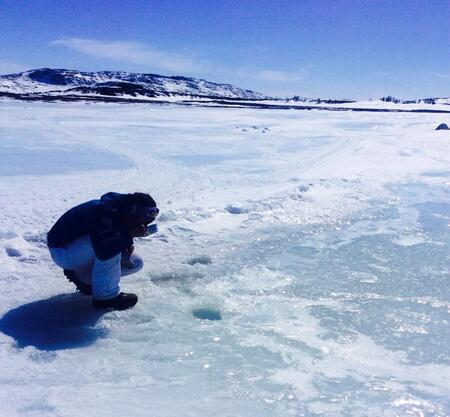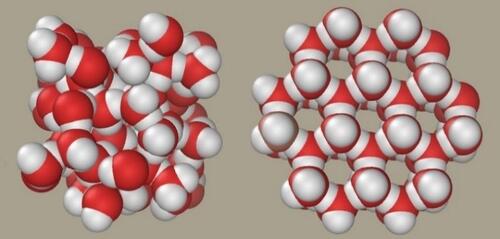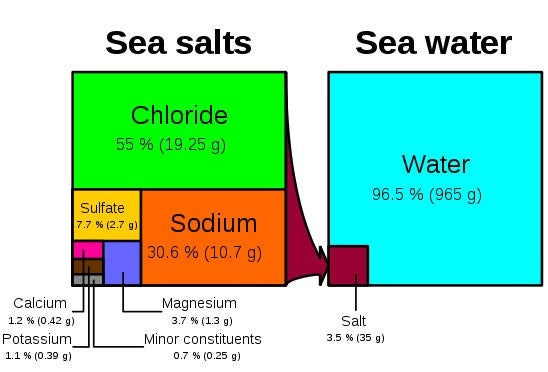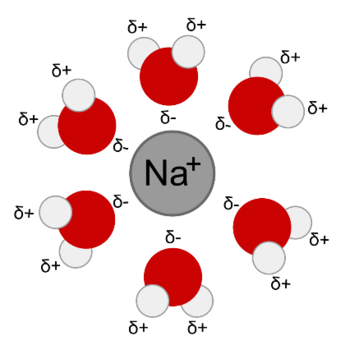This article is the fourth part in a continuing series on chemistry and Inuit life and culture. Inuit culture is passed down from generation to generation orally, and the use of storytelling is an important function. For this particular article, we consider that such a digression here not only illustrates this, but also provides a linguistically-rich way of showing how essential sea ice is to the very survival of the peoples.
Sikuk (Sea Ice): A gateway to freedom
F IGURE 1
IGURE 1
Chaim Andersen going to imittak (fetch water),
drinking surface fresh water out of a tin bowl
on the sea ice. Credit: Mary Andersen
The Inuit are geographically located in the circumpolar Arctic where temperatures reach extreme cold. Temperatures do not start to climb back up until late spring while the summer months are shorter and cooler than what are experienced in southern Canada. Essentially, then, Inuit live half of their lives in subzero temperatures. So, along with the sometimes elegant and sometimes aggressive snowfalls, sea ice is part of Inuit life for a substantial portion of the year (Fig. 1).
In terms of utilization, Inuit use the sea ice mainly for transportation. For a people who live in isolated Arctic communities, access to the outside is only by very expensive seats on small Twin Otter aircraft or, in the brief summer, by the weekly coastal boat. The ability to travel from their permanent homes to their home on the land is crucial: to go hunting and fishing; to carry out their culture/traditions; and to rid themselves of cabin fever. These are major privileges, among many others, provided by the sea ice. In this way, Inuit can not only provide for themselves, their families and their community, but also heal their mind, their body and their soul. Thus, the sea ice is a crucial infrastructure in Inuit culture, and it is a gateway to freedom across their lands and (frozen) seas.
A small personal tangent
 FIGURE 2
FIGURE 2
Maria Merkuratsuk and Chaim Andersen. Credit: Maria Merkuratsuk
“There are two times throughout the year where we are stranded in our communities, in the spring when the ice is starting to melt and between fall and winter when the ice isn’t formed enough. I have a friend, Maria Merkuratsuk (Fig. 2); she is also an Inuit from Nain, Nunatsiavut (our hometown) and my elder. She has taught me many things about our culture/language and continues to do so through stories of her life growing up. One of my favourites is the story of the “first freeze up”. Every year when the ice is finally thick enough to travel on, she and her family (a big one at that) and friends get ready early in the morning to go fishing for iKaluk (Arctic char) in a place we call Anaktalik. If you’ve ever seen a bunch of Inuit ice-fishing for iKaluit (plural of iKaluk) you might think there was a spiritual ritual happening of some sort. It is the most exciting event and one of my most favourite things to do! Everyone is either screaming out “Woo, I got a fish” or “Bugger, I dropped it” although I cannot capture Maria’s beautiful and vivid accounts in Inuttitut (our own language1). The ice allows us to engage in activities that bring us together, to break free of our town-boundaries. Even just the smell of the air while travelling makes me happy. I always say, and I’ve always felt in my heart, I am a person of the land and sea, both when it is frozen and when it is not, and I am sure all other Inuit can relate.”
Oxygen solubility in sea water
 FIGURE 3
FIGURE 3
Worldwide concentration of dissolved
oxygen in oceans5
It may seem odd to discuss the topic of oxygen solubility in an article on Inuit life and sea ice, but it is a crucial component. There are very few food resources on land in the far north, while the sea is rich in fish and mammals. Access to the sea is essential to survival, hence nearly all of the Canadian Inuit communities are on the coast. The prolific sea life is largely dependent upon the high oxygen concentration necessary for the gills of the fish. In fact some species, such as Arctic char (see part two of our series2), thrive only in high dissolved- oxygen levels.3 Oxygen solubility is inversely proportional to temperature;4 thus the near-zero temperature of Arctic waters provides this marine bounty (see Fig. 3).
Why does ice float?
Outside of the brief warm months, to access the marine food resources, the surface sea ice is essential. Thus the fact that ice floats on liquid water is key to survival in northern Canada. Yet this behaviour is unique to water – or nearly so.
For ‘normal’ compounds, the solid form is denser than the liquid form. We explain this observation in terms of the Kinetic-Molecular (K-M) Model of Matter: that is, in the solid phase, molecules are locked in fixed locations in the crystal lattice. The molecules vibrate about these fixed locations, with the vibrational energy increasing with increasing temperature. Melting occurs when the vibrational energy exceeds the intermolecular forces between neighbouring molecules. As the molecules become free to move, spaces open up, reducing the bulk density in the liquid phase.
 FIGURE 4
FIGURE 4
Space-filling representations of the structure of liquid water and solid water (ice)7
Why is water so different? We must compare the molecular structure of liquid water and of ice (Fig. 4). In liquid water, the molecules are free to move over each other. However, in ice, the water molecules are held in their crystal location by hydrogen bonds at fixed angles to the neighbouring water molecules. How can it expand to form such an open structure? The answer lies with the high strength of the hydrogen bonds (21 kJ·mol-1).6 This rigid open structure means that there are molecule-size channels through the ice, reducing the bulk density to about 0.9 that of liquid water.
Sea water and northern ice formation
Of course, sea water is not pure H2O: it contains several dissolved ions, as shown in Fig. 5.
The presence of these ions lowers the temperature of the solid-liquid transition. We can explain this behaviour in terms of the electrostatic interaction between each ion and the neighbouring polar water molecules (Fig. 6). These interactions inhibit the formation of the hydrogen-bonding network amongst the water molecules themselves, lowering the liquid-solid transition temperature to about -2 °C.
FIGURE 5
The ion composition of sea water — quantities in relation to 1 kg or 1 litre of sea water8
FIGURE 6
Clustering of polar water molecules around a sodium ion9
In the freezing process for salt water, the molecular vibrations of the water molecules decrease until they are less than the strength of the intermolecular hydrogen bonds. As the water molecules lock into fixed positions, the ions are ‘pushed out’. Thus frozen sea ice is essentially fresh water while the water beneath the ice becomes richer in ions (more saline) and denser, thus sinking to the bottom of the Arctic Ocean and driving the deep water currents. In fact, in spring, freshwater pools form on the surface, as shown by Chaim drinking fresh water in Fig. 1.
The worrying future for the Inuit
 To southern Canadians, the dramatic reduction in months of ice coverage of Arctic waters is usually discussed in terms of shipping access to the Arctic. It is rarely (if ever) mentioned that the loss of Arctic ice will be catastrophic for the Inuit. If Inuit are unable to travel widely over the sea ice, traditional way of life and the marine harvesting, which provides the basis of their healthy diet, will be difficult, if not impossible, to continue. The resources themselves (particularly Arctic char) are also likely to diminish as warming water will reduce the oxygen concentration of the seas.
To southern Canadians, the dramatic reduction in months of ice coverage of Arctic waters is usually discussed in terms of shipping access to the Arctic. It is rarely (if ever) mentioned that the loss of Arctic ice will be catastrophic for the Inuit. If Inuit are unable to travel widely over the sea ice, traditional way of life and the marine harvesting, which provides the basis of their healthy diet, will be difficult, if not impossible, to continue. The resources themselves (particularly Arctic char) are also likely to diminish as warming water will reduce the oxygen concentration of the seas.
PHOTO
Chaim’s three-year-old daughter, Avery Andersen, ice fishing.
Footnote
Chaim Andersen has also been involved in the development of the Labrador Inuit Settlement Marine Management Plan – Imappivut.
References
- Inuttitut is the distinct Labrador Inuit variant of the Inuktituk language. See: Wikipedia. Inutttitut. https://en.wikipedia.org/wiki/ Inuttitut.
- C.C. Andersen and G. Rayner-Canham, “Soy Sauce — An essential Inuit condiment,” Chem 13 News, October 2018.
- Wikipedia. Arctic char. https://en.wikipedia.org/wiki/Arctic_char.
- The Engineering Toolbox: Oxygen — Solubility in Fresh Water and Sea Water, https://www.engineeringtoolbox.com/oxygen-solubility-water-d_841.html.
- Wikimedia Commons. Sea-surface oxygen [mol O^2 m^-3]. commons. https://commons.wikimedia.org/wiki/File:WOA09_sea-surf_O2_AYool.png.
- Wikipedia. Hydrogen bonds. https://en.wikipedia.org/wiki/ Hydrogen_bond.
- Wikimedia Commons. Liquid water and ice. https://commons. wikimedia.org/wiki/File:Liquid-water-and-ice.png.
- Wikipedia. Magnesium chloride. https://en.wikipedia.org/wiki/ Magnesium_chloride#/%20media/File:Sea_salt-e-dp_hg.svg.
- Wikipedia. Solvation shell. https://en.wikipedia.org/wiki/ Solvation_shell.
For Future Reading, A Selection
- Aporta, C.; Taylor, D.R.F.; Laidler, G.J. Geographies of Inuit sea ice use: introduction. Canadian Geographer 2011, 55 (1), 1-5.
- Bravo, M.T. Voices from the Sea Ice: the reception of climate change narratives. Journal of Historical Geography 2009, 35, 256-278.
- Durkalec, A. et al. Climate change influences on environment as a determinant of Indigenous health: Relationships to place, sea ice, and health in an Inuit community. Social Science & Medicine 2015, 136-137, 17-26.
- Ford, J.D. Dangerous climate change and the importance of adaptation for the Arctic’s Inuit population. Environmental Research Letters 2009, 4, 1-9.
- Laidler, G.J. et. al. Travelling and hunting in a changing Arctic: Assessing Inuit vulnerability to sea ice change in Igloolik, Nunavut. Climatic Change 2009, 94, 363-397.
- Riew, R. Inuit use of the sea ice. Arctic and Alpine Research 1991, 23, 3-10.
Publisher's note: This article is a reprint from the February 2019 issue of Chem 13 News.







